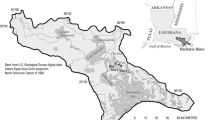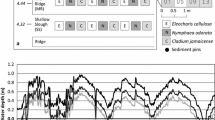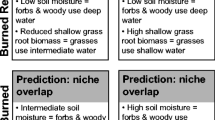Abstract
Interaction of herbivory by wintering lesser snow geese (Anser caerulescens caerulescens), environmental conditions, and burning were investigated in a mid-Texas coastal marsh dominated byScirpus americanus (Olney bulrush). Goose grubbing and use ofS. americanus rhizomes and roots initially produced a patchwork of denuded and vegetated areas on a recently burned area. Regrowth occurred by reestablishment of uprooted shoot complexes; regeneration from seed was not observed. Regrowth was dependent on intensity of use and post-herbivory environmental conditions. After three years of varying levels of goose use and environmental conditions, lowest foliar cover and standing crop occurred in areas with a high frequency and intensity of goose use followed by spring drought and high salinities. Greatest growth was associated with low frequency and intensity of use followed by normal spring freshwater inflows and low salinities. Burning did not significantly affect the response ofS. americanus. Continued frequent and intense snow goose use, coupled with high salinity and extended periods with water levels below the marsh surface, can produce denuded mudflats subject to accelerated soil erosion. Management strategies to reduce the impact of these combined events could be implemented. Hydroperiod and salinity conditions should be routinely monitored, and goose populations should be temporally and spatially directed to reduce the potential for conversion of marsh to permanent mudflats.
Similar content being viewed by others
Literature Cited
Alisauskas, R.T. 1988. Winter diets and nutrition of midcontinental lesser snow geese. Journal of Wildlife Management 52:403–414.
Bellrose, F.C. 1976. Ducks, Geese and Swans of North America. Stackpole Books, Harrisburg, PA, USA.
Cargill, S.M. and R.L. Jefferies. 1984. the effects of grazing by lesser snow geese on the vegetation of a sub-arctic salt marsh. Journal of Applied Ecology 21:669–686.
Chabreck, R. H. 1988. Coastal Marshes. University of Minnesota Press, Minneapolis, MN, USA.
Chou, R., C. Vardy, and R.L. Jefferies. 1992. Establishment from leaves and other plant fragments produced by the foraging activities of geese. Functional Ecology 6:297–301.
Daubenmire, R. 1959. A canopy-coverage method of vegetation analysis. Northwest Science 33:43–64.
de la Cruz, A.A. and C.T. Hackney. 1980. The effects of winter fire and harvest on vegetational structure and primary productivity of low tidal marsh communities in Mississippi, Mississippi-Alabama Sea Grant Consortium, Ocean Springs, MS, USA. Publication M-AS6P-80-013.
Giroux, J.F. and J. Bedard. 1987a. Effects of simulated feeding by snow geese onScirpus americanus rhizomes. Oecologia 74:137–143.
Giroux, J.F. and J. Bedard. 1987b. Factors influencing aboveground production ofScirpus marshes in the St. Lawrence Estuary, Quebec Canada. Aquatic Botany 29:195–204.
Giroux, J.F. and J. Bedard. 1987c. The effects of grazing by greater snow geese on the vegetation of tidal marshes in the St Lawrence estuary. Journal of Applied Ecology 24:773–788.
Griffith, R.E. 1940. Waterfowl management on Atlantic Coastal refuges. Transactions North American Wildlife Conference 5:373–377.
Hartman, J.M. 1988. Recolonization of small disturbance patches in a New England salt marsh. American Journal of Botany 75: 1625–1631.
Hatch, S.L., K.N. Gandhi, and L.E. Brown. 1990. Checklist of the Vascular Plants of Texas. Texas Agricultural Experiment Station, College Station, TX, USA. MP-655.
Hik, D.S. and R.L. Jefferies. 1990. Increases in the net above-ground primary production of a salt-marsh forage grass: a test of the predictions of the herbivore-optimizing model. Journal of Ecology 78:180–195.
Hoffpauir, C.M. 1961. Methods of measuring and determining the effects of marsh fires. Proceedings of the Annual Conference Southeast Association Game and Fish Commissioners 15:142–161.
Jefferies, R.L., A. Jensen, and K.F. Abraham. 1979. Vegetational development and the effect of geese on vegetation at La Perouse Bay, Manitoba. Canadian Journal of Botany 57:1439–1450.
Kerbes, R.H., P. M. Kotanen, and R.L. Jefferies. 1990. Destruction of wetland habitats by lesser snow geese: a keystone species on the west coast of Hudson Bay. Journal of Applied Ecology 27: 242–258.
Lynch, J.J., T. O’Neil, and D.W. Lay. 1947. Management significance of damage by geese and muskrats to Gulf Coast marshes. Journal of Wildlife Management 11:50–76.
Martin, A.C. and F.M. Uhler. 1951. Food of game ducks in the United States and Canada. U.S. Department of the Interior, Fish & Wildlife Service, Washington, DC, USA. Resource Report. No. 30.
McAtee L. 1910. Notes onChen caerulescens. C. rossi, and other waterfowl in Louisiana. Auk 27:337–339.
McIlhenny, E.A. 1932. The blue goose in its winter home. Auk 49: 279–306.
Meeder, J.F. and E. Perry. 1990. Ecosystem impacts and recovery rates of overgrazing by snow geese and muskrat in brackish marshes in southwest Louisiana. Bulletin of the Ecological Society of America 71:249.
Miller, D. L., F.E. Smeins, and J.W. Webb. 1996. Mid-Texas coastal marsh change (1939–1991) as influenced by lesser snow geese herbivory. Journal of Coastal Research 12:462–476.
National Cooperative Soil Survey. 1981. Soil survey of Brazoria County, Texas. U.S. Department of Agriculture, Soil Conservation Service, in cooperation with Brazoria County Commissioners Court and Texas Agricultural Experimental Station. Fort Worth, TX, USA.
Nyman J.A., M. Carloss, R.D. DeLaune, and W.H. Patrick, Jr. 1994. Erosion rather than plant dieback as the mechanism of marsh loss in an estuarine marsh. Earth Surface Processes and Landforms 19: 69–84.
Palmisano, A.W. Jr. and J.D. Newsom. 1967. Ecological factors affecting occurrence ofScirpus olneyi andScirpus robustus in Louisiana coastal marshes. Proceedings of the Annual Conference of the Southeastern Association of Game & Fish Commission 21: 161–172.
Robertson, D.G. and R.D. Slack. 1995. Landscape change and its effects on the wintering range of a lesser snow goose population: a review. Biological Conservation 71:179–185.
SAS Institute, Inc. 1982. SAS Users Guide: Statistics. SAS Institute Inc., Cary, NC, USA.
Smeins, F.E., D. D. Diamond, and C.W. Hanselka. 1992. Coastal Prairie. p. 269–288.In R.T. Coupland, (ed.) Ecosystems of the World: 8A. Natural Grasslands: Introduction to the Western Hemisphere. Elsevier, New York, NY, USA.
Smith, L.M., J.A. Kadlec, and P.V. Fonnesbeck. 1984. Effects of prescribed burning on nutritive quality of marsh plants in Utah. Journal of Wildlife Management 48:286–288.
Smith, L.M. and J.A. Kadlec. 1985. Fire and herbivory in a Great Salt Lake marsh. Ecology 62:98–106.
Smith, T.J. III and W.E. Odum. 1981. The effects of grazing by snow geese on coastal salt marshes. Ecology 62:98–106.
Stutzenbaker, C.D. and M.W. Weller. 1989. The Texas coast. p. 385–405In L.M. Smith, R.L. Pederson, and R.M. Kaminski (eds.) Habitat Management for Migrating and Wintering Waterfowl in North America. Texas Tech University Press, Lubbock, TX, USA.
Thornthwaite, C.W. 1948. An approach toward a rational classification of climate. Geographical Review 38:185–311.
White, J. 1979. The plant as a metapopulation. Annual Review of Ecological Systems 10:109–145.
White W.A., T.R. Calnan, R.A. Morton, R.S. Kimble, T.G. Littleton, W. H. McGowen, and H. S. Nance. 1988. Submerged Lands of Texas, Bay City-Freeport Area: Sediments, Geochemistry, Benthic Macro Invertebrates, and Associated Wetlands. The University of Texas at Austin, Bureau of Economic Geology, Austin, TX, USA.
Author information
Authors and Affiliations
Rights and permissions
About this article
Cite this article
Miller, D.L., Smeins, F.E., Webb, J.W. et al. Regeneration ofScirpus americanus in a Texas coastal marsh following lesser snow goose herbivory. Wetlands 17, 31–42 (1997). https://doi.org/10.1007/BF03160716
Received:
Revised:
Accepted:
Issue Date:
DOI: https://doi.org/10.1007/BF03160716




